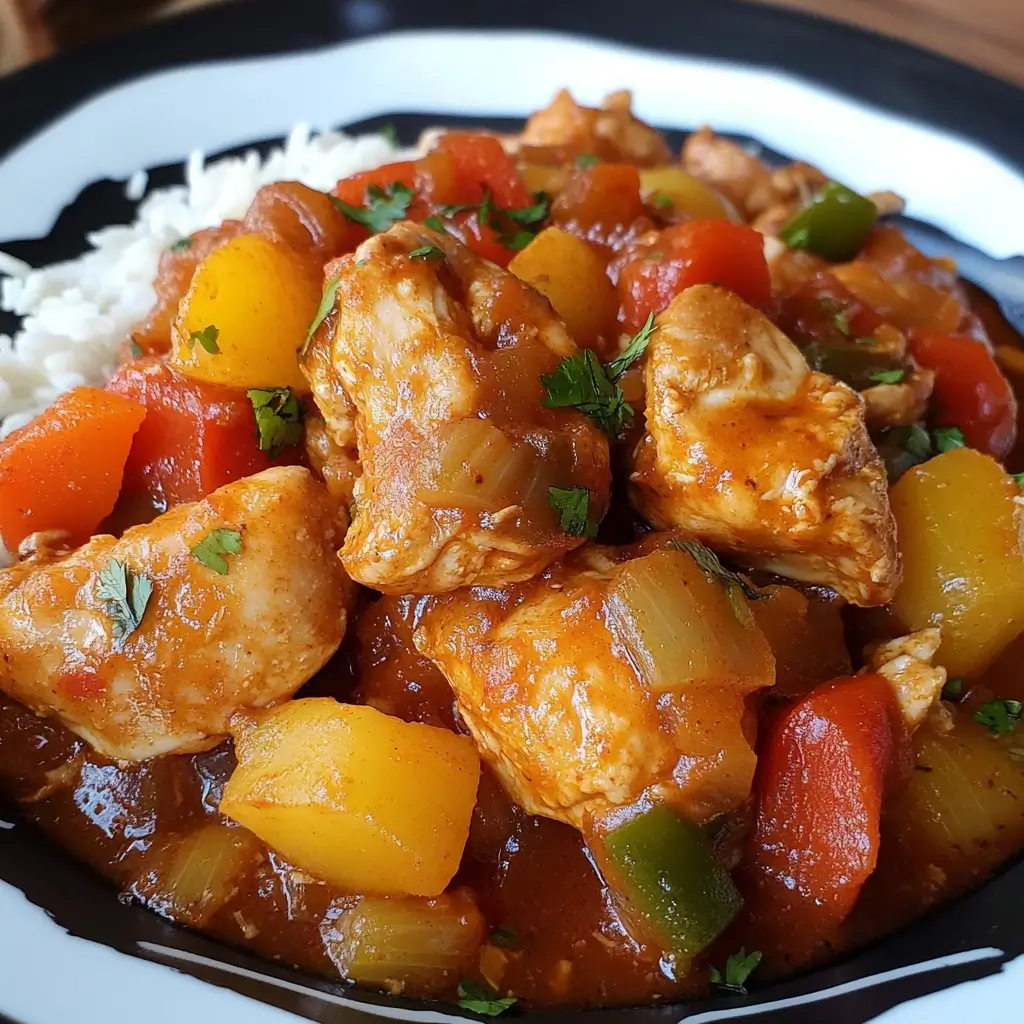Ah, Chicken Afritada! The mere mention of this dish transports me back to my grandmother’s bustling kitchen, the air thick with the comforting aroma of simmering tomatoes, tender chicken, and vibrant vegetables. This isn’t just a recipe for me; it’s a hug in a bowl, a taste of home that never fails to bring a smile to my face. When I first attempted to recreate her magic, I was nervous, but the beauty of Afritada lies in its forgiving nature. My family now requests this specific version regularly, praising its perfectly balanced sauce – not too acidic, not too sweet – and the way the chicken just falls off the bone. The potatoes and carrots absorb the rich, savory broth, becoming little flavor bombs, while the bell peppers add a delightful sweetness and a pop of color. It’s become our go-to for weeknight dinners and a star at family gatherings. The best part? It’s surprisingly simple to make, yet delivers a complex, deeply satisfying flavor profile that feels like it took hours to develop. This recipe, honed over many trials, is my tribute to those cherished memories and a way to share that warmth with you.
The Ultimate Chicken Afritada: A Filipino Comfort Classic
Chicken Afritada is a cornerstone of Filipino cuisine, a hearty and flavorful tomato-based chicken stew beloved for its simplicity and deliciousness. Its name, derived from the Spanish word “fritada” (meaning “fried”), hints at its colonial heritage, yet the dish has been thoroughly embraced and adapted into the Filipino culinary landscape. Typically featuring chicken pieces simmered with potatoes, carrots, and bell peppers in a rich tomato sauce, Afritada is a vibrant, comforting, and incredibly satisfying meal. It’s a dish that graces everyday dinner tables and festive gatherings alike, showcasing the Filipino talent for creating complex flavors from straightforward ingredients.
Why You’ll Love This Chicken Afritada Recipe
- Incredibly Flavorful: The combination of savory chicken, sweet vegetables, and tangy tomato sauce, enhanced with aromatics, creates a symphony of tastes.
- Easy to Make: Despite its rich flavor, Afritada is surprisingly straightforward to prepare, making it perfect for both weeknight dinners and special occasions.
- Wholesome and Hearty: Packed with protein and vegetables, it’s a nutritious and filling meal.
- Crowd-Pleaser: Its universally appealing flavors make it a hit with both kids and adults.
- Customizable: Easily adaptable to your preferences – add a bit of spice, include green peas, or even throw in some hot dogs for a classic Filipino twist.
- One-Pot Wonder: Minimizes cleanup, which is always a bonus!
Ingredients for Chicken Afritada (Complete List with Amounts)
This recipe aims for a balanced, deeply flavorful Afritada that serves a family generously.
- For the Chicken & Marinade (Optional, but Recommended for Depth):
- 1.5 kg (approx. 3.3 lbs) bone-in, skin-on chicken pieces (thighs and drumsticks work best), cut into serving sizes
- 2 tablespoons soy sauce
- 1 tablespoon calamansi juice or lemon juice
- 1/2 teaspoon freshly ground black pepper
- Aromatics:
- 2 tablespoons cooking oil (vegetable, canola, or light olive oil)
- 1 large yellow onion, chopped (about 1.5 cups)
- 6-8 cloves garlic, minced (about 2 tablespoons)
- Vegetables:
- 3 medium potatoes (approx. 500g or 1.1 lbs), peeled and quartered or cut into 1.5-inch cubes
- 2 medium carrots (approx. 250g or 0.55 lbs), peeled and sliced into 1/2-inch thick rounds or large dice
- 1 large red bell pepper, cored, seeded, and cut into 1-inch squares or thick strips
- 1 large green bell pepper, cored, seeded, and cut into 1-inch squares or thick strips
- 1 cup frozen green peas (optional, but adds color and sweetness)
- Sauce Base & Seasonings:
- 1 can (15 oz / 425g) tomato sauce
- 2-3 tablespoons tomato paste (for deeper flavor and color)
- 1.5 – 2 cups chicken broth or water (adjust for desired sauce consistency)
- 2-3 dried bay leaves
- 3 tablespoons fish sauce (patis) – adjust to taste
- 1 teaspoon sugar (optional, to balance tomato acidity)
- Salt and freshly ground black pepper to taste
- Optional Enhancers (Classic Additions):
- 2-3 pieces Filipino-style red hotdogs or smoked sausages, sliced diagonally (optional)
- 1-2 tablespoons liver spread (Reno brand is traditional, adds richness and umami) (optional)
Step-by-Step Instructions for Perfect Chicken Afritada
Follow these detailed steps to create a delicious and authentic Chicken Afritada:
- Marinate the Chicken (Optional but Recommended – 30 minutes to 1 hour):
- In a large bowl, combine the chicken pieces with soy sauce, calamansi/lemon juice, and black pepper. Toss well to coat. Let it marinate in the refrigerator for at least 30 minutes, or up to an hour, to allow the flavors to penetrate the meat. This step significantly enhances the chicken’s taste.
- Prepare the Vegetables:
- While the chicken is marinating (if you opted for this step), prepare all your vegetables. Peel and chop the potatoes and carrots. Core, seed, and chop the bell peppers. Chop the onion and mince the garlic. Having everything ready (mise en place) makes the cooking process smoother.
- Pro Tip: Keep the cut potatoes submerged in a bowl of water to prevent them from browning until you’re ready to use them. Drain well before adding to the pot.
- Sear the Chicken:
- In a large, heavy-bottomed pot or Dutch oven, heat the cooking oil over medium-high heat.
- Once the oil is hot, remove the chicken from the marinade (discard any excess marinade) and pat it slightly dry with paper towels (this helps with browning).
- Carefully place the chicken pieces in the hot oil, ensuring not to overcrowd the pot (work in batches if necessary).
- Sear the chicken on all sides until nicely browned, about 3-4 minutes per side. This step is crucial for developing a deep, savory flavor (Maillard reaction).
- Remove the browned chicken from the pot and set it aside on a plate. Don’t worry if it’s not cooked through at this point; it will finish cooking in the sauce.
- Sauté Aromatics and Build Sauce Base:
- In the same pot, using the remaining oil and chicken drippings (add a little more oil if needed), reduce the heat to medium.
- Add the chopped onions and sauté until softened and translucent, about 3-5 minutes.
- Add the minced garlic and cook for another minute until fragrant, being careful not to burn it.
- Stir in the tomato paste and cook for 1-2 minutes, stirring constantly. This “toasts” the tomato paste, deepening its flavor and reducing its raw acidity.
- Pour in the tomato sauce. Stir well to combine with the aromatics.
- Simmer the Chicken:
- Return the browned chicken pieces to the pot.
- Add the chicken broth (or water), bay leaves, and fish sauce (patis). If using, add the sliced hotdogs/sausages now.
- Bring the mixture to a gentle simmer. Once simmering, reduce the heat to low, cover the pot, and let it cook for 20-25 minutes, or until the chicken is about halfway tender. Stir occasionally to prevent sticking.
- Add Hardy Vegetables:
- Add the cubed potatoes and sliced carrots to the pot. Gently stir them into the sauce.
- If the liquid level seems too low (it should just about cover the vegetables and chicken), add a little more broth or water.
- Cover the pot again and continue to simmer for another 10-15 minutes, or until the potatoes and carrots are almost tender when pierced with a fork.
- Add Softer Vegetables and Enhancers:
- Stir in the sliced red and green bell peppers.
- If using, add the frozen green peas and the liver spread (if desired). Stir the liver spread well into the sauce until it dissolves and incorporates, enriching the sauce.
- Continue to simmer, uncovered or partially covered, for another 5-7 minutes, or until the bell peppers are tender-crisp and the peas are cooked through. You want the bell peppers to retain some of their vibrant color and slight crunch.
- Taste and Adjust Seasoning:
- This is a critical step. Taste the sauce carefully.
- Add the optional teaspoon of sugar if you find the tomato sauce a bit too acidic. Sugar helps balance the flavors.
- Adjust with more fish sauce (for saltiness and umami) or salt and freshly ground black pepper as needed to suit your preference. The sauce should be savory, slightly tangy, and well-seasoned.
- Rest Before Serving:
- Once the Afritada is cooked and seasoned to perfection, turn off the heat.
- Let the dish rest for at least 10-15 minutes before serving. This allows the flavors to meld together even more, resulting in a more delicious final product. The sauce will also thicken slightly as it cools.
Nutrition Facts
- Servings: This recipe yields approximately 6-8 servings.
- Calories per serving (estimated): Approximately 400-550 calories.
- Disclaimer: This is a rough estimate. Actual calorie content can vary significantly based on the specific cut of chicken used (skin-on vs. skinless, thigh vs. breast), exact ingredient quantities, brands of canned goods, and serving size. For precise nutritional information, it’s best to use an online recipe nutrition calculator with your exact ingredients.
Preparation & Cooking Time
- Preparation Time: 25-30 minutes (includes optional marinating prep and chopping vegetables)
- Marinating Time (Optional): 30 minutes to 1 hour
- Cooking Time: Approximately 50-65 minutes
- Total Time (excluding optional marination): Approximately 1 hour 15 minutes to 1 hour 35 minutes
- Total Time (including optional marination): Approximately 1 hour 45 minutes to 2 hours 5 minutes
How to Serve Chicken Afritada
Chicken Afritada is traditionally served hot and is wonderfully versatile. Here are some serving suggestions:
- The Classic Pairing:
- Serve generously over a bed of freshly steamed white rice. The rice is perfect for soaking up the rich, savory tomato sauce. This is the quintessential way to enjoy Afritada.
- Bread Accompaniment:
- Offer crusty bread, like a Filipino pandesal or a simple baguette, on the side for dipping into the delicious sauce.
- Garnishes for Extra Flair:
- A sprinkle of freshly chopped cilantro or flat-leaf parsley can add a touch of freshness and color.
- A few fried garlic bits sprinkled on top can add a delightful crunchy texture and extra garlic aroma.
- Side Dish Complements:
- A simple green salad with a light vinaigrette can provide a refreshing contrast.
- Atchara (Filipino pickled green papaya) offers a tangy and sweet counterpoint that cuts through the richness of the stew.
- For a Crowd or Potluck:
- Serve buffet-style directly from the pot or transfer to a chafing dish or slow cooker set to “warm” to keep it at the perfect temperature.
- A Squeeze of Acidity:
- Offer wedges of calamansi or lime on the side for those who like an extra citrusy zing.
Additional Tips for the Best Chicken Afritada (5 Tips)
- Don’t Skip Searing the Chicken: This is paramount for flavor. The browning process (Maillard reaction) creates a depth of savory notes that you won’t achieve by simply boiling the chicken in the sauce. It also helps render some fat and gives the chicken a better texture.
- Use Bone-In, Skin-On Chicken: While boneless, skinless chicken can be used, bone-in, skin-on pieces (especially thighs and drumsticks) contribute significantly more flavor to the stew and remain more moist during the simmering process. The bones release collagen, which enriches the sauce.
- Layer Your Vegetables by Cooking Time: Add heartier vegetables like potatoes and carrots first, as they take longer to cook. Softer vegetables like bell peppers and peas should be added towards the end to prevent them from becoming mushy and to preserve their color and texture.
- Taste and Adjust Seasoning Religiously: The “taste and adjust” step is crucial for any stew. Tomato-based sauces can vary in acidity. Don’t be afraid to add a pinch of sugar to balance, more fish sauce for umami and saltiness, or freshly ground pepper for a bit of a kick. Your palate is the best guide.
- Let it Rest After Cooking: Like many stews, Chicken Afritada tastes even better after it has had some time to rest off the heat (at least 10-15 minutes). This allows the flavors to meld and deepen. It’s often even more flavorful the next day!
Frequently Asked Questions (FAQ) about Chicken Afritada
- Q: Can I use boneless, skinless chicken breast for Afritada?
- A: Yes, you can. However, be mindful that chicken breast cooks faster and can dry out more easily than bone-in, skin-on dark meat. If using breast, cut it into larger chunks and consider adding it a bit later in the cooking process or reducing the overall simmering time for the chicken. Searing it well is still recommended.
- Q: How can I make my Chicken Afritada spicy?
- A: To add some heat, you can include 1-2 chopped siling labuyo (Filipino bird’s eye chili) or a pinch of red pepper flakes along with the garlic and onions. Alternatively, a dash of your favorite hot sauce can be stirred in at the end. Adjust the amount to your preferred spice level.
- Q: How do I store and reheat leftover Chicken Afritada?
- A: Allow the Afritada to cool completely, then transfer it to an airtight container. It can be stored in the refrigerator for 3-4 days or frozen for up to 2-3 months. To reheat, gently warm it on the stovetop over medium-low heat, adding a splash of water or broth if the sauce has thickened too much. You can also reheat individual portions in the microwave.
- Q: What’s the difference between Chicken Afritada, Mechado, and Caldereta?
- A: These are all Filipino stews, often tomato-based, but with key differences.
- Afritada: Typically the mildest and simplest, featuring chicken (or pork) with potatoes, carrots, and bell peppers in a basic tomato sauce.
- Mechado: Often made with beef (traditionally larded with pork fat), soy sauce, and calamansi juice, giving it a tangier, more savory profile. It usually includes potatoes and sometimes bell peppers.
- Caldereta: Traditionally made with goat meat (but beef or chicken are common), it’s richer and often spicier. It frequently includes liver spread or peanut butter for thickening, cheese, olives, and sometimes chili.
- A: These are all Filipino stews, often tomato-based, but with key differences.
- Q: Can I add other vegetables to my Chicken Afritada?
- A: Absolutely! While potatoes, carrots, and bell peppers are traditional, feel free to add other vegetables like sweet potatoes (cut smaller as they cook faster), celery (add with onions), or even green beans (add towards the end). This is a great way to customize the dish to your liking or use up vegetables you have on hand. Just be mindful of their respective cooking times.
This Chicken Afritada recipe is more than just a set of instructions; it’s an invitation to experience the warmth and comfort of Filipino home cooking. Whether you’re a seasoned cook or new to Filipino cuisine, this dish is sure to become a beloved favorite in your household, just as it is in mine. Enjoy the process, savor the aromas, and delight in the delicious results!
Print
Chicken Afritada Recipe
Ingredients
-
- For the Chicken & Marinade (Optional, but Recommended for Depth):
-
- 1.5 kg (approx. 3.3 lbs) bone-in, skin-on chicken pieces (thighs and drumsticks work best), cut into serving sizes
-
- 2 tablespoons soy sauce
-
- 1 tablespoon calamansi juice or lemon juice
-
- 1/2 teaspoon freshly ground black pepper
-
- For the Chicken & Marinade (Optional, but Recommended for Depth):
-
- Aromatics:
-
- 2 tablespoons cooking oil (vegetable, canola, or light olive oil)
-
- 1 large yellow onion, chopped (about 1.5 cups)
-
- 6–8 cloves garlic, minced (about 2 tablespoons)
-
- Aromatics:
-
- Vegetables:
-
- 3 medium potatoes (approx. 500g or 1.1 lbs), peeled and quartered or cut into 1.5-inch cubes
-
- 2 medium carrots (approx. 250g or 0.55 lbs), peeled and sliced into 1/2-inch thick rounds or large dice
-
- 1 large red bell pepper, cored, seeded, and cut into 1-inch squares or thick strips
-
- 1 large green bell pepper, cored, seeded, and cut into 1-inch squares or thick strips
-
- 1 cup frozen green peas (optional, but adds color and sweetness)
-
- Vegetables:
-
- Sauce Base & Seasonings:
-
- 1 can (15 oz / 425g) tomato sauce
-
- 2–3 tablespoons tomato paste (for deeper flavor and color)
-
- 1.5 – 2 cups chicken broth or water (adjust for desired sauce consistency)
-
- 2–3 dried bay leaves
-
- 3 tablespoons fish sauce (patis) – adjust to taste
-
- 1 teaspoon sugar (optional, to balance tomato acidity)
-
- Salt and freshly ground black pepper to taste
-
- Sauce Base & Seasonings:
-
- Optional Enhancers (Classic Additions):
-
- 2–3 pieces Filipino-style red hotdogs or smoked sausages, sliced diagonally (optional)
-
- 1–2 tablespoons liver spread (Reno brand is traditional, adds richness and umami) (optional)
-
- Optional Enhancers (Classic Additions):
Instructions
-
- Marinate the Chicken (Optional but Recommended – 30 minutes to 1 hour):
-
- In a large bowl, combine the chicken pieces with soy sauce, calamansi/lemon juice, and black pepper. Toss well to coat. Let it marinate in the refrigerator for at least 30 minutes, or up to an hour, to allow the flavors to penetrate the meat. This step significantly enhances the chicken’s taste.
-
- Marinate the Chicken (Optional but Recommended – 30 minutes to 1 hour):
-
- Prepare the Vegetables:
-
- While the chicken is marinating (if you opted for this step), prepare all your vegetables. Peel and chop the potatoes and carrots. Core, seed, and chop the bell peppers. Chop the onion and mince the garlic. Having everything ready (mise en place) makes the cooking process smoother.
-
- Pro Tip: Keep the cut potatoes submerged in a bowl of water to prevent them from browning until you’re ready to use them. Drain well before adding to the pot.
-
- Prepare the Vegetables:
-
- Sear the Chicken:
-
- In a large, heavy-bottomed pot or Dutch oven, heat the cooking oil over medium-high heat.
-
- Once the oil is hot, remove the chicken from the marinade (discard any excess marinade) and pat it slightly dry with paper towels (this helps with browning).
-
- Carefully place the chicken pieces in the hot oil, ensuring not to overcrowd the pot (work in batches if necessary).
-
- Sear the chicken on all sides until nicely browned, about 3-4 minutes per side. This step is crucial for developing a deep, savory flavor (Maillard reaction).
-
- Remove the browned chicken from the pot and set it aside on a plate. Don’t worry if it’s not cooked through at this point; it will finish cooking in the sauce.
-
- Sear the Chicken:
-
- Sauté Aromatics and Build Sauce Base:
-
- In the same pot, using the remaining oil and chicken drippings (add a little more oil if needed), reduce the heat to medium.
-
- Add the chopped onions and sauté until softened and translucent, about 3-5 minutes.
-
- Add the minced garlic and cook for another minute until fragrant, being careful not to burn it.
-
- Stir in the tomato paste and cook for 1-2 minutes, stirring constantly. This “toasts” the tomato paste, deepening its flavor and reducing its raw acidity.
-
- Pour in the tomato sauce. Stir well to combine with the aromatics.
-
- Sauté Aromatics and Build Sauce Base:
-
- Simmer the Chicken:
-
- Return the browned chicken pieces to the pot.
-
- Add the chicken broth (or water), bay leaves, and fish sauce (patis). If using, add the sliced hotdogs/sausages now.
-
- Bring the mixture to a gentle simmer. Once simmering, reduce the heat to low, cover the pot, and let it cook for 20-25 minutes, or until the chicken is about halfway tender. Stir occasionally to prevent sticking.
-
- Simmer the Chicken:
-
- Add Hardy Vegetables:
-
- Add the cubed potatoes and sliced carrots to the pot. Gently stir them into the sauce.
-
- If the liquid level seems too low (it should just about cover the vegetables and chicken), add a little more broth or water.
-
- Cover the pot again and continue to simmer for another 10-15 minutes, or until the potatoes and carrots are almost tender when pierced with a fork.
-
- Add Hardy Vegetables:
-
- Add Softer Vegetables and Enhancers:
-
- Stir in the sliced red and green bell peppers.
-
- If using, add the frozen green peas and the liver spread (if desired). Stir the liver spread well into the sauce until it dissolves and incorporates, enriching the sauce.
-
- Continue to simmer, uncovered or partially covered, for another 5-7 minutes, or until the bell peppers are tender-crisp and the peas are cooked through. You want the bell peppers to retain some of their vibrant color and slight crunch.
-
- Add Softer Vegetables and Enhancers:
-
- Taste and Adjust Seasoning:
-
- This is a critical step. Taste the sauce carefully.
-
- Add the optional teaspoon of sugar if you find the tomato sauce a bit too acidic. Sugar helps balance the flavors.
-
- Adjust with more fish sauce (for saltiness and umami) or salt and freshly ground black pepper as needed to suit your preference. The sauce should be savory, slightly tangy, and well-seasoned.
-
- Taste and Adjust Seasoning:
-
- Rest Before Serving:
-
- Once the Afritada is cooked and seasoned to perfection, turn off the heat.
-
- Let the dish rest for at least 10-15 minutes before serving. This allows the flavors to meld together even more, resulting in a more delicious final product. The sauce will also thicken slightly as it cools.
-
- Rest Before Serving:
Nutrition
- Serving Size: One Normal Portion
- Calories: 400-550





